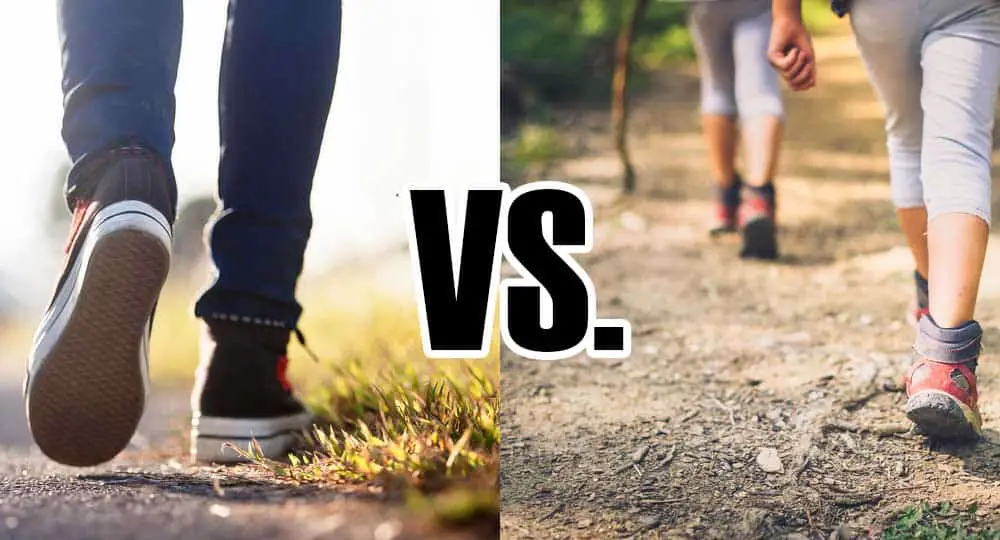Hiking Vs. Walking: Similarities And Differences

When we’re all little, around the age of one, we start to get the hang of this magical thing called walking. Once we get the hang of it, it’s pretty hard to ever forget how to do it. From our first steps forward, we learn to use that gift of mobility to achieve some pretty awesome feats that extend beyond leisurely walking. That can enter the territory that can be commonly known as hiking.
Many people may argue that walking and hiking are one and the same, but we’re here to tell you that while there are some similarities, there are also some key differences between the two activities.
So what’s the difference between hiking and walking?
Quick Links
Hiking Vs. Walking: Differences
Purpose
While both hiking and walking can be done for pleasure or exercise, the final destination for either activity can look very different. If you’re hiking, chances are you’re not hiking to the grocery store like you would on a regular walk. On a hike, you may have a grand final destination such as a mountain peak or a waterfall. On a walk, although you could technically walk to a mountain or a river, you’re more likely to use walking as a means of casual transportation in urban areas that have flat terrain.
Pace
With walking, you get to control the pace that you go at. It can be as consistent or as inconsistent as you feel. There’s very little physical risk involved with walking, save maybe a few irresponsible bikers or drivers out on the street. It’s a bit different from hiking in that the pace that you need to abide by depends on the elevation and the terrain you’re traversing on. The steeper the elevation and more rigid the terrain, the slower you might have to go to ensure that you do not injure yourself.
Terrain
Speaking of rigid terrain, that’s another key difference between hiking and just plain old walking. When you’re walking, it’s more likely than not that you’re walking in a more urbanized area such as a city. The terrain of cities tends to be flat and smooth, making walking very easy and accessible to everyone (unless you’re in California, of course.) On the flip side, hikes are almost always in nature. Whether that be in a mountain forest or a coastal pathway, an integral component of hiking is that you are out in nature, away from the hustle and bustle of everyday urban life.
Physical Exertion
With hiking, there can often come a certain level of physical challenge that may push you to your limits. Although hiking technically isn’t a sport, it does require a level of physical exertion that can be quite similar to participating in one. With steep uphill climbs and terrain that may sometimes incorporate scrambles where you have to incorporate your hands, the level of physical exertion needed to participate in a hike is far greater than going on a casual walk through your local park.
Comparatively, on a walk, you’re burning far fewer calories and exerting far less energy than if you were to go on a hike. The flat terrain doesn’t offer much of a challenge and is very easy on the limbs and joints. There’s also less danger from insect bites, rashes from plants, dangerous falls, dehydration, and any risk associated with being out in nature.
Distance
Depending on who you ask in certain parts of the world, a walk can be any length of distance. For Europeans especially, a nice casual walk can include physical exertions that look quite similar to a hike. But if you ask most people in the US and North America, a hike, although an unofficial rule, begins after the 2nd mile. So technically, a cool and casual walk can turn into a hike after 2 miles, but what makes a hike a real official hike, would be the hilly terrain that comes on natural pathways.
Gear
With walking, the most you’ll probably need is a really good pair of walking shoes and a bottle of water, especially if you’re planning to walk for a distance. With hiking, however, depending on the level of difficulty, you may have to consider taking a lot more gear with you.
Gear that should be considered when going on a hike should be a great pair of hiking boots, a hiking backpack to store snacks and water, an extra pair of clothes, camping material, and trekking poles. There’s ultimately going to be a bit more weight on you if you decide to trek into the great outdoors for a hike, which may feel a bit more restricting than if you were going on a casual walk through your neighborhood.
Cost efficiency
Walks are usually always free unless, of course, you decide to make a stop at your local ice cream parlor for a sweet treat. Conversely, while hikes can absolutely be free, depending on where you choose to hike, there can typically be some sort of fee, especially if you’re planning to hike in a national park. This fee may be for parking, or for entrance into the hiking trails themselves. Keep this in mind next time you’re planning your next hiking adventure.
Now that we’ve gotten the major difference between hiking and walking out of the way, let’s get into some ways in which hiking and walking are similar.
Hiking Vs. Walking: Similarities
Health benefits
Both hiking and walking offer some excellent health benefits that are easy and accessible to come by. Walking consistently for 30-45 minutes a day can contribute to a longer life expectancy with its ability to reduce one’s risk of diabetes and heart disease. It can also positively influence one’s mental health with physical activity helping to alleviate some symptoms that come along with depression and anxiety. Hiking can benefit if a very similar way, just a bit more intensely.
Hiking regularly can contribute to significant weight loss and muscle building. Both activities can help to improve muscle tone and strengthen cardiovascular endurance which can help us to lead a healthier, longer life.
Nature exposure
Whether you’re walking or hiking, you’re getting out of the house, which in itself is a great benefit to you physically and mentally. Reconnecting with the outside world, whether you’re in a metropolitan area or a mountain town is a great way to recenter yourself and get your mental and physical health on track.
Getting more exposure to the sunlight just by itself is a great way to find yourself reconnected with nature and even offers an immunity boost that will help you fight illnesses later on. The boost of oxygen you’ll get from being outside around all of the greenery can also help with cognitive functioning.
Hiking may offer you a bit more of an immersive experience in nature than if you were in a city. Hiking can expose you to a true sense of quiet, which can help you tune into nature, and ultimately tune into yourself. You can observe wildlife, running bodies of water, and towering trees that you may not experience in a city. That’s not to say that some cities don’t offer substantial natural areas, but trekking out on a hike will offer you more of that full embrace of the outdoors.
Social benefits
Walking and hiking can both be a great way to reconnect with loved ones or make new friends. A casual walk in the park can be a great activity that can serve as a way to catch up with your friends, spend time with your kids, or get romantic with your partner.
It’s one of the easiest social activities you can do with the people in your life. The same can be said for hiking, although it will probably be more of a challenge for everyone, depending on their level of physical fitness. Hiking can be a great way to show the people in your life how much you support them, especially when faced with physical challenges.

Is Hiking Better than Walking?
Now that we’ve gone over some of the key similarities and differences between hiking and walking, you might be wondering which one is better for you. And the answer to that question is… it depends! It really just comes down to what you’re looking to get out of your experience and what kind of environment you want to do it in.
If you’re looking for a more rigorous workout with some great health benefits, then hiking is probably the better option for you. If you’re just looking for a way to get outside and take in some fresh air, then a leisurely walk might be more your speed. And if you’re somewhere in the middle, then you can always mix things up and do a little bit of both! No matter what you choose, you’re sure to reap some great benefits.
At What Point Does a Walk Turn Into a Hike?
I wouldn’t say that there’s a distance, but rather a difference in purpose or goal. A hike is a journey with a specific destination or objective in mind, while a walk is simply, a walk. It’s just strolling around aimlessly with no real destination in mind.
So I guess you could say that the main difference between a hike and a walk is intent. If you’re just out for a leisurely stroll, then it’s a walk. But if you’re out to explore, especially outside of the city, and you have a specific goal destination, then it’s a hike!
Additionally, as I mentioned earlier, hikes are usually done through more rugged or difficult terrain than walks are. So if you’re on a path or gravel road surrounded by nature, it’s safe to consider it a hike.
Conclusion
Now that you’ve gotten a good detailed description of what the difference between walking and hiking is, let’s wrap it all up in a nice little bow.
The main differences between hiking and walking will be the purpose, terrain, physical exertion, and the amount of gear you use. On the other hand, the greatest similarities between the two activities will ultimately be the awesome health benefits, social benefits, and exposure to the great outdoors that all humans need to be happy and healthy.
Whether you choose to go on a walk or a hike today, just remember to enjoy yourself and take in all the beautiful sights around you!






